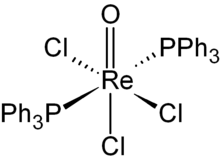Chemistry:Oxotrichlorobis(triphenylphosphine)rhenium(V)

| |
| Names | |
|---|---|
| IUPAC name
Trichloridooxido
| |
| Identifiers | |
3D model (JSmol)
|
|
| ChemSpider | |
PubChem CID
|
|
| |
| |
| Properties | |
| ReOCl3(PPh3)2 | |
| Molar mass | 833.15 g/mol |
| Appearance | yellow microcrystals |
| Melting point | 205 °C (401 °F; 478 K) |
| not soluble in water | |
Except where otherwise noted, data are given for materials in their standard state (at 25 °C [77 °F], 100 kPa). | |
| Infobox references | |
Oxotrichlorobis(triphenylphosphine)rhenium(V) is the chemical compound with the formula ReOCl3(PPh3)2. This yellow, air-stable solid is a precursor to a variety of other rhenium complexes.[1] In this diamagnetic compound, Re has an octahedral coordination environment with one oxo, three chloro and two mutually trans triphenylphosphine ligands. The oxidation state of rhenium is +5 and its configuration is d2.
Synthesis
ReOCl3(PPh3)2 is commercially available, but it is readily synthesized by reaction of perrhenic acid with triphenylphosphine in a mixture of hydrochloric acid and acetic acid. In this reaction, Re(VII) is reduced to Re(V), and triphenylphosphine is oxidized to its oxide.
- HReO4 + 3 HCl + 3 PPh3 → ReOCl3(PPh3)2 + Ph3PO + 2 H2O
The required perrhenic acid solution can be prepared in situ from rhenium(VII) oxide.
Uses
ReOCl3(PPh3)2 is a precursor to a variety of other oxo-, nitridio, and hydrido complexes. It converts to ReH7(PPh3)2 by a treatment with LiAlH4.[2]
ReOCl3(PPh3)2 catalyzes the selective oxidation of secondary alcohols by DMSO, producing the corresponding ketals.[3]
References
- ↑ Johnson, N. P.; Lock, C. J. L.; Wilkinson, G. (1967). "Complexes of Rhenium(V)". Inorganic Syntheses. 9. 145–148. doi:10.1002/9780470132401.ch39. ISBN 978-0-470-13240-1.
- ↑ K. Abdur-Rashid; A. J. Lough; R. H. Morris (2001). "Intra- and inter-ion-pair protonic-hydridic bonding in polyhydridobis(phosphine)rhenates". Canadian Journal of Chemistry 79 (5–6): 964. doi:10.1139/cjc-79-5-6-964.
- ↑ Pombeiro, A. J. L.; Fatima, M.; Crabtree, R. H. "Technetium and Rhenium: Inorganic & Coordination Chemistry" Encyclopedia of Inorganic Chemistry. John Wiley & Sons: New York, 2006. doi:10.1002/0470862106.ia237
 |

